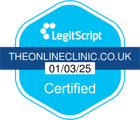Synalar
Synalar is used to treat inflamed or allergic skin conditions such as dermatitis, eczema, and some cases of psoriasis.
Can I get Synalar online?
The Online Clinic can prescribe Synalar online following a quick online consultation. All you have to do is complete the consultation form, which will then be reviewed by a doctor.
What is Synalar?
Synalar contains a corticosteroid medicine known fluocinolone acetonide. It can be used to relieve red, swollen, painful and itchy skin due to an inflamed or allergic skin condition, particularly when the condition ‘flares up’. It stops the skin cells from releasing substances that cause inflammation. The medicine comes as a cream or an ointment, and in different strengths. Synalar preparations containing antibiotic medicines are also available for when your skin has become infected. These include Synalar C that contains fluocinolone with clioquinol, and Synalar N that contains fluocinolone with neomycin.
How to use Synalar
Synalar is for topical use on the skin. Your doctor will tell you exactly how often, how much, and how long to use the preparation. Synalar is usually applied thinly to the affected skin area once or twice a day. As with all topical medicines, wash your hands before use, and then again after use (unless it is your hands that require the treatment). A small amount of the cream or the ointment is rubbed into the affected area of skin. The amount to apply is measured in ‘fingertip units’ — that is from the tip of your finger to the first bend of that finger. For an adult, one fingertip unit is sufficient for an area twice the size of the hand. Do not cover the area with an occlusive dressing unless you have been told by your doctor to do so. Apply the medicine for as long as your skin is inflamed. Treatment is usually for about 7–10 days, and 5 days if used on the face or by children. If the problem continues after this time then seek advice from your doctor because this type of medicine should not be used for a long time, particularly on large skin areas.
Taking precautions, such as not using Synalar under occlusive dressings and for longer than instructed, will keep absorption as expected and minimise the risk of side effects. Synalar containing fluocinolone only should not be used on areas of damaged or infected skin. In such cases use the Synalar C or Synalar N preparations that contain an antibacterial. Avoid your eyes, mouth and nose. Rinse them thoroughly if you accidently get the medicine in them. Seek medical advice if you use too much or swallow a lot. If you forget to apply Synalar, then do so as soon as possible (if the next scheduled application is some time away).
Who can use Synalar?
Synalar can be used in children aged one year and older, adolescents and adults. Synalar should not be used on your skin if you have an allergy to the active ingredient (fluocinolone) or to the other ingredients in the preparation. The cream and ointment can exacerbate some skin conditions, e.g. psoriasis, and make them worse once discontinued. It should not be used in cases of acne, the long-term facial skin condition known as acne rosacea, a mouth rash called perioral dermatitis, nappy rash, and itching around the genitals or anus. Also people with bacterial infections (e.g. impetigo), fungal infections (e.g. thrush or athlete’s foot) or viral infections (e.g. chicken pox or herpes) should avoid using Synalar.
As with all medicines, notify your doctor if you are pregnant or are breastfeeding, as Synalar should not be used during these times (particularly on large areas, for long periods, and/or under occlusive dressings) unless really necessary. If breastfeeding, ensure the medicine is thoroughly washed off the breast before allowing your baby to feed, and reapply it later.
Synalar side effects
Side effects reported to occur with Synalar include itching, burning, and redness of the treated skin, and an allergic inflammatory skin condition known as contact dermatitis. If too much Synalar is used over a long time period then you could have depigmentation of the skin, the appearance of small blood vessels under the skin, and develop stretch marks (or striae) and thinning of the skin. Moreover, if too much of the medicine is absorbed into the blood stream, other side effects may occur such as a reduction in the amount of the natural hormones produced by the adrenal glands or a roundness of the face.
GMC registration number: 4524038

Date: 23 January 2024
Next review: 22 January 2026
All UK registered doctors can have their registration checked on
The Medical Register at the GMC website.
Synalar Reviews By Our Patients
-
Works quickly to clear up my psoarisis. No stickiness, it is a clear gel.
-
works very all is now under control,and is now used very occasionally as and when needed
-
Great service, quick and reliable
-
Excellent service thank you
Skin and Nails News
NICE Examines New Psoriasis Treatment
NICE Begins Approval Process for New Treatment for Severe Psoriasis Draft guidelines that back the use of Almirall�s new product Skilarence, for the treatment of moderate or severe plaque psoriasis by the National Health Service in the United Kingdom, have been issued by the National Institute…
Read full article >Duac Gel in Stock
After being out of stock for a while owing to a manufacturing problem, we are pleased to report that Duac Once Daily Gel is back in stock. Duac is a popular prescription acne treatment that contains Benzoyl Peroxide and Clindamycin. If you have already been approved for this product through our…
Read full article >Trimovate Finally Back in Stock
We are delighted to announce that Trimovate is back in stock and available for next day delivery. This product is an almost indispensable medication, so it is good to have it back in stock after a manufacturing problem that has gone on for well over a year. Trimovate is one of the few products…
Read full article >







